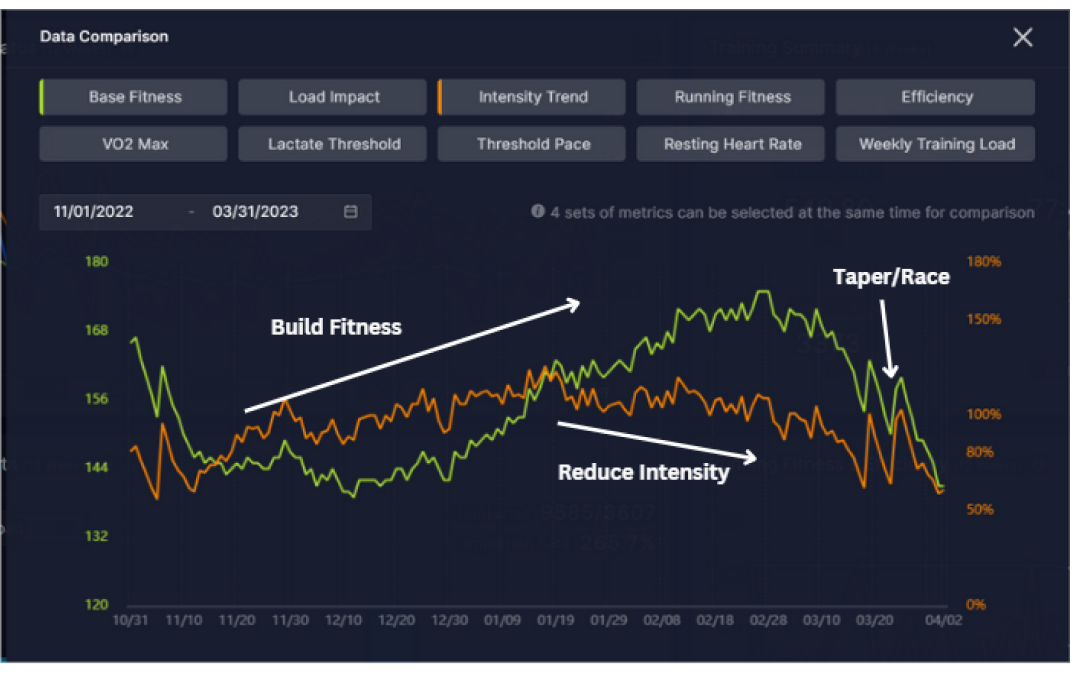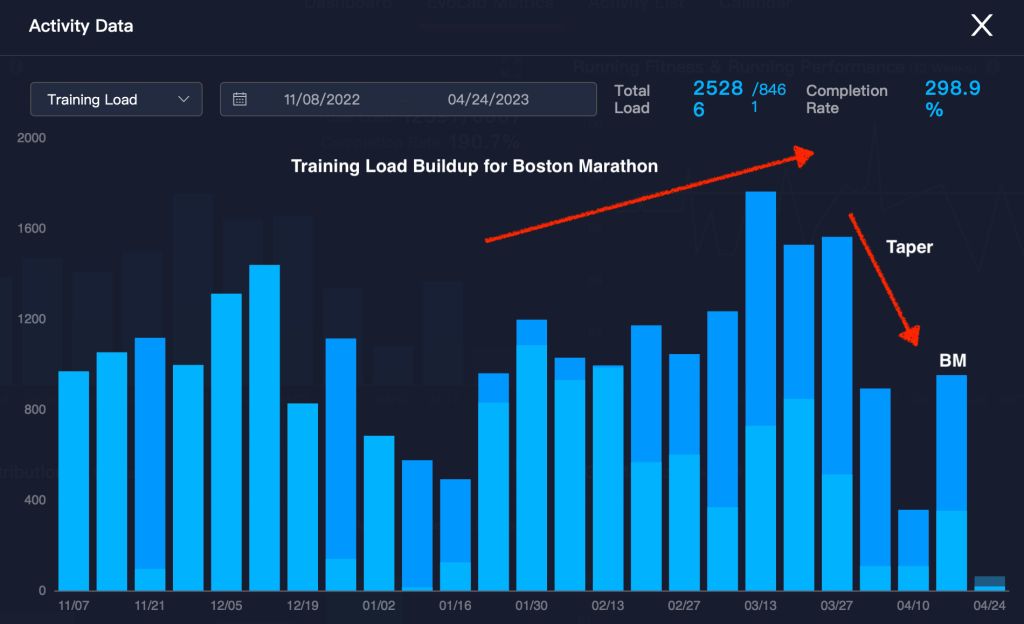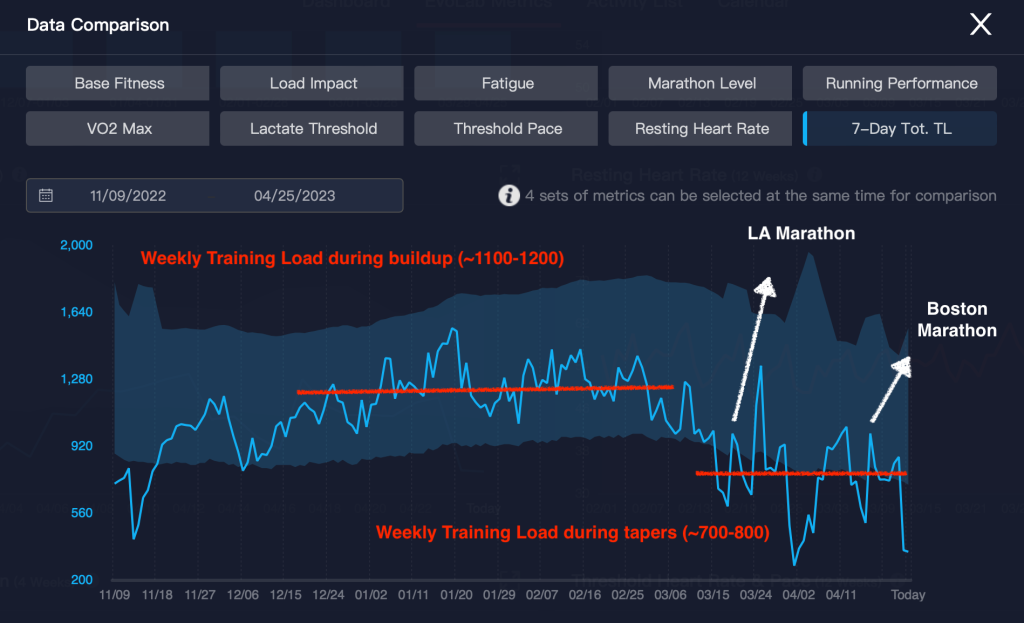As race day approaches, your training goals shift. Instead of working hard and building fitness, your time is better spent recovering and ensuring you feel good on race day. "The hay is in the barn", as they say, and additional hard work would hinder rather than help your final performance. In this article, we'll take a deep look at this "Taper" phase of the training plan, and how you can use it to maximize your race results.
What is a Taper?
A taper refers to the phase of training leading up to a race where you gradually reduce the volume and intensity of your workouts. The goal is to allow your body to recover fully while maintaining fitness so that you can perform at your peak on race day.
During a taper, you will maintain some level of intensity to keep your fitness sharp but significantly cut back on overall mileage and effort, ensuring you’re rested, fresh, and at your best when it matters most.

Training Status graph found in your COROS Training Hub
What to do during a taper?
There are several steps to follow during a taper to ensure a proper recovery without losing fitness. We have broken down tapering into 3 simple steps:
- Training Load - The main focus of a taper is to reduce the training load. This can be done by either decreasing your current volume and/or intensity. But you will see below that one may be better than the other.
- Volume - During the taper, volume is the part of training that you will notice a change in first. You should aim to roughly decrease it by about 50%. Doing so frees up time for recovery habits such as nutrition, sleep, and others.
- Intensity - On the other hand, workout intensities during taper should become very similar to the race demands. Depending on what you were working on before tapering, you may have to increase or reduce your intensity to meet the race demands as much as possible.
How long should a taper last?
The length of a taper depends on the type of race and the individual. Some runners will require 3-4 weeks of gradual decrease while some may perform well with only a week. A great rule of thumb, however, is the longer the race, the longer the taper should be.
- Marathon distance: A taper typically lasts 2 to 3 weeks. The first week reduces overall training volume but keeps some intensity with your goal race pace, while the final week focuses on recovery, with light sessions to keep the legs fresh.
- Half Marathon distance: A taper of 10-14 days is common. During this period, you should reduce training volume but maintain some faster-paced work to stay sharp.
- Shorter distances (5k or 10k): These shorter races generally require a shorter taper, usually around 5-7 days. You can still include race-pace workouts but reduce overall mileage and focus on recovery.
The goal is to balance rest with maintaining enough intensity to stay race-ready without overtraining or leaving you feeling sluggish.

A progressive decrease in weekly training load during taper prior to the Boston Marathon
EvoLab Analysis
As you train with your COROS watch, you can access multiple graphs within your Training Hub. Some of them can greatly help in monitoring your training and ensure that you are recovering enough during the taper. Below, we have included three different graphs that all will play a role in your taper monitoring.
Base Fitness & Intensity Trend
Once again, the Training Load Management Chart is your bread and butter for most training monitoring.
- Intensity Trend - Aim to bring your Intensity Trend value down to roughly 50-80% during taper for optimized recovery. This will put your Training Status in the Performance zone.
- Base Fitness - Aim to hold your Base Fitness score within roughly 5-10% during taper. For example, if you have built up your Base Fitness to 100 during training, aim to get to race day at a Base Fitness of about 90.
COROS EDUCATION: Base Fitness is your long-term stress score. It is completely normal, and it is even recommended to see a slight decrease during tapering as it would prove that your body is recovering.
Weekly Training Load
As mentioned before, training load is the main focus of tapering. The Weekly Training Load chart shown earlier in this blog is a great indicator of how much work you put in before and during tapering.
Aim to bring down your weekly TL score to roughly 50%. For example, the athlete below shows a weekly training load of ~700 during the taper compared to nearly ~1200 during their build-up.

Reduction in weekly training load during tapering prior to the Boston Marathon
Pace Zone Distribution
The EvoLab Pace Zones Distribution graph is another useful tool for managing your taper. It helps you check if you're hitting the right intensities as you prepare for race day.
During your taper, aim to spend more time training in the pace zones you'll be racing at. For instance, if you were doing faster speed workouts before tapering for a marathon, you might need to lower the intensity. On the other hand, if you were doing mostly easy long runs, you might need to pick up the intensity a bit.
By following this approach, you can focus on your marathon pace, recover properly, and still be ready for race day.
The graphs below show an increase in zones 1 and 2 during tapering for the Boston Marathon, a race completed mostly within zone 3 (Aerobic Power).


/filters:quality(90)/fit-in/970x750/coros-web-faq/upload/images/043f8b6ad0696ec16c1a4c47004061b6.jpg)





